Each year more than 5 billion pigs, cows, calves, turkeys, and fish are killed in the United States for food. On factory farms where most meat, dairy, and eggs come from, animals are crammed into cages so small that they cannot even turn around. Babies are taken from mothers, often as soon as they are born. Male chicks in egg facilities are ground up alive. Disease is so prevalent in these conditions that antibiotics are routinely fed to animals causing antibiotic resistance in humans,the largest threat to human health today. In the developing nations, animals are used for labor. The more efficient, compassionate, and cost effective solution would be to use sustainable energy fueled vehicles.
Chickens are farmed more than any other animal. Over nine billion chickens are produced, and slaughtered each year. The scale of their suffering is unimaginable. Tens of thousands of chickens are kept in sheds where there is no natural light. The air is unbreathable due to ammonia from urine. Baby chicks have their beaks and toes cut off to prevent fighting due to extreme overcrowding. Debeaking cuts through bone, cartilage, and soft tissue without benefit of pain relief. Chickens raised for meat are genetically altered to grow twice as fast, and twice as large, as normal chickens. This causes multiple health issues for these birds. Unhealthy living conditions expose the chickens to all kinds of disease.
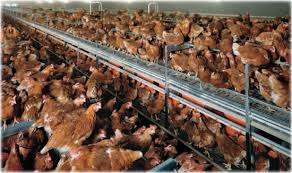
Transportation to slaughter is done by the cheapest means possible. The chickens are packed in crates on the backs of trucks unprotected from weather conditions. Birds literally freeze to death in winter, or die from heat stress, and suffocation in summer. At the slaughterhouse, crates of chickens are removed from trucks with cranes or forklifts, and dumped on a conveyor belt. As birds are unloaded, some fall on the floor where they die from being crushed by machinery or vehicles, or they die slowly from starvation, and neglect. Fully conscious birds are hung by their feet on a moving rail. Stunning is not required because chickens and poultry are not covered by the Humane Slaughter Act. They are killed as cheaply as possible, regardless of the additional suffering it causes. The birds’ throats are slashed, usually by a mechanical blade which often misses. Then the dead, and the live chickens, are submerged in boiling water. Birds missed by the killing blade are boiled alive. This is such a common occurrence that these birds are called ‘redskins’. Don’t eat chickens.
Eggs are produced by huge agribusiness corporations. Hens are kept in crowded battery cages where their most basic instincts are cruelly violated. There is no natural light. Four or five hens are in each cage. They cannot walk, or stretch their wings. Their feathers fall out, their skin becomes raw, and often bloody, and their feet are injured, and often caught, by the wire floor. When the hen’s feet become caught in the wire floor, it can prevent her from reaching food. Hens can slowly starve to death inches from food. Dead hens remain in the cage with living hens.
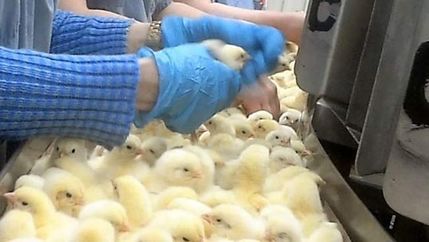
To prevent cannibalism, hens are debeaked. A hot blade cuts through bone, cartilage, and soft tissue. Many birds die from shock during the process. The industry uses enormous amounts of antibiotics, pesticides, and other chemicals. Pesticides are fed to the hens so that their excrement attracts fewer flies. Eggs yolks are chemically dyed to achieve a yellow look, which in nature comes from the sun.
When egg production falls off, the industry starves, and denies hens water, for several days. This ‘forced molting’ shocks the hens into losing whatever feathers they have left, and starts a new egg laying cycle. Many hens die during this tortuous cycle. There is no veterinary care. Dying hens are thrown on ‘dead piles’ with the dead hens.Male chicks are of no use to the egg industry. Newborn baby male chicks are thrown into plastic garbage bags. They suffocate slowly under the weight of the other chicks dumped on top of them. Male chicks are also ground up for animal feed while still alive. Don’t eat eggs, or anything made with eggs.
Turkeys are slaughtered at the rate of about 300 million a year. Most turkeys are raised in confinement. Disease and suffering are rampant in these inhumane conditions. Stressed turkeys are driven to fighting, causing ‘economic’ loss. To prevent ‘loss’, the turkey’s beaks and toes are cut off without pain relief. Turkeys have been anatomically manipulated to grow abnormally fast and large. If a seven pound baby grew at the same rate as the turkeys are forced to, the baby would weigh 1500 pounds at 18 weeks of age. When turkeys reach market weight, they are packed in crates, and shipped to slaughter. Fully conscious turkeys are hung upside down by metal shackles. They suffer from pain, and terror, as they are carried on a conveyor belt. Then they have their throats cut. They are not stunned, and as a result, turkeys are bled to death while fully conscious. The killing methods are not precise, so many turkeys go into tanks of boiling water while still alive. Don’t eat turkeys.
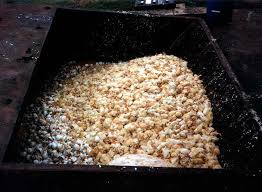
Foie Gras is produced from ducks and geese who are a few months old. These unfortunate birds are confined in dark sheds, and force fed large amounts of food several times a day. A worker grabs the bird, and forces a metal pipe down its neck. Then a mechanized pump shoots a mixture of corn and oil directly into their gullets. This is done for a few weeks, during which time many birds die from ruptured, punctured throats, burst stomachs, and other ailments. They are dehydrated because they are not given sufficient amounts of water. In addition, they are often debeaked to prevent stressed birds from injuring each other in crowded conditions. Debeaking is done by a hot blade cutting through bone, cartilage, and soft tissue without any pain relief. The birds’ enlarged livers are sold as a ‘gourmet’ food item after a horrific slaughter. Foie gras production is banned in the United Kingdom, Austria, Czech Republic, Denmark, Finland, Sweden, Norway, Poland, Switzerland, and Israel. It should be banned in the United States also.
Beef cattle are often born, and live, on ranches unprotected from inclement weather. Thousands die because ranchers do not think it is economical to provide shelter, or veterinary care to injured, ill or otherwise ailing animals. 30,000 dairy cows recently perished in south western USA as a result of a severe snow storm. They were buried alive. The Government reimbursed these cruel ranchers for the deaths of the cows, which they caused! These animals have holes punched in their ears for identification tags. These tags have numbers, not names. Cattle are branded with hot irons, which is extremely painful and traumatic. Cattle are often transported for hundreds or thousands of miles. By law, they are allowed to travel for up to 36 hours without food or water. Thousands of cattle die every year from overcrowding or stress. At stockyards and auctions, frightened animals are kicked or shocked, and sold to the highest bidder. From there they go to slaughter or a feedlot. Younger cattle spend the last few months of their lives ingesting growth hormones, and being fed an abnormal diet designed to produce fast growth. Sick and diseased livestock are common in these filthy places. Small planes flying over can smell the stench from high above the feedlots. At slaughter, conditions make it nearly impossible to treat the animals with any semblance of humanity. Although cattle are covered by the Human Slaughter Act, it is seldom enforced. Don’t eat beef.
Dairy cows live short, confined lives of forced births, unnatural feeds, painful injections, and calcium depleted bones. To produce milk, dairy cows must give birth. They produce a calf a year, which is taken from them soon after birth. Mother cows mourn the loss of their baby calves. The cows endure a physically demanding nine month gestation period, during which time they give milk for the first seven months. With genetic mutation, cows produce 100 pounds of milk a day – ten times more than in nature. Their udders are so heavy and swollen that they are in constant pain and are unable to walk properly. Hormones banned in Europe and Canada are used in the United States to increase milk production. This causes birth defects in the calves.
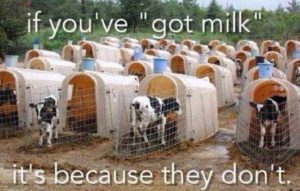
The cows are fed unnatural diets which cause disease, some of which are fatal. All dairy cows suffer from diseases directly related to the way they are treated. In nature, cows live about 20 years, in the dairy industry, they are ‘unproductive’, spent, and slaughtered at about three or four years old. They are slaughtered in horrific ways, and become low grade hamburger, and low quality beef products. Don’t eat or drink dairy.
“Downed cows” are worn out, depleted dairy cows who are so weak, and diseased from the lives they have been forced to live, that they cannot stand. These “downers” are still sold for human consumption. They are typically left without food, water, or care, for days until it is convenient to take them to slaughter. Usually they are moved by the most convenient, least humane ways, such as being dragged or pushed with tractors or forklifts. This causes even more suffering and injuries. Downed animals are not protected from abuse under federal animal welfare laws, no matter how cruel the treatment is.
Veal calves are the by-product of the dairy industry. Male calves are not able to produce milk, so they are taken from their mothers, chained by the neck, and kept in crates so small they cannot turn around, stretch, or lie down. Their muscles are not able to develop, keeping their meat ‘tender’. They are fed a poor diet, making them anemic. These sick, abused animals produce pale-colored flesh. These inhumane conditions cause the calves to be more likely to develop diseases than cattle in more normal circumstances. Veal calves requires copious amounts of medication to keep them alive until slaughter at a few months of age. Veal is the most likely meat to contain illegal drug residues which pose a threat to human consumption.
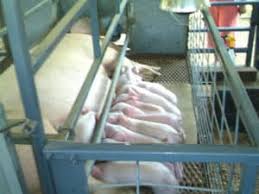
Humane Meat, Milk, and Eggs. All animals raised “humanely” are subjected to the same cruel transportation, handling, and slaughter methods as factory farmed animals. Poultry is not covered by the Humane Slaughter Law. All chickens are killed as cheaply as possible without any consideration for the amount of suffering it causes. ‘Humane’ chickens are still debeaked. Male chicks in the ‘humane’ egg industry are still suffocated, or ground up. ‘Free range’ eggs do not have any set standard. The hens may simply be in slightly larger cages, or be allowed out in barren dirt areas for brief times. Cows used for ‘humane’ milk are still repeatedly impregnated. Their babies are taken from them. They are forced to give milk while pregnant, and they are forced to produce more milk than they would in nature. Unwanted male calves in the ‘humane’ dairy industry are still sold for veal as young as a few days old. No animal, humanely raised or not, volunteers for a horrific slaughter. Don’t be fooled by false claims.
Pigs. Approximately 100 million pigs are raised and slaughtered in the United States every year. In nature, pigs live in social groups in light woodlands. They are as intelligent as dogs, naturally very clean, and are very active. Pregnant sows build large nests where they give birth, and protect their piglets. The piglets are weaned in nature from milk to solid food at 10 – 20 weeks.
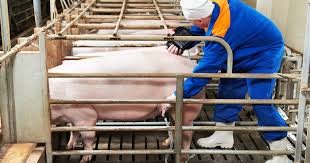
In factory farms, piglets are taken from their grieving Mothers as young as three weeks old. They are housed in indoor barren, over crowded pens. There is no straw or other bedding. They lie on concrete. Each sow is forced to have 20 piglets per year. Of all pigs, the breeding sows are treated the most cruelly. They live in a continual cycle of artificial insemination from masturbated male pigs, birth, and re-impregnation. The sows are confined in small, metal gestation crates. For their entire lives, the sows cannot walk or turn around, and barely have room to stand up. They are denied straw bedding, and must lie on concrete. They mourn the loss of their babies, as any other mother would. Their physical, and psychological suffering is immense.
After piglets are taken from their mothers, their tails are cut off with pliers, or a hot docking iron, without pain relief causing permanent pain. Males are castrated without pain relief. The mutilations cause pain, illness, and even death. Approximately 15% of the piglets die soon after leaving their mothers. The surviving pigs endure horrific circumstances until their death at six months of age. After three or four years, the breeding sows are no longer deemed productive, and are sent to slaughter. Don’t eat pork, ham, or bacon.

Toronto Pig Save is a Canadian organization of people who witness outside a slaughterhouse. They give the doomed pigs an act of kindness, which is probably the first, and last of their lives. Starving, thirsty pigs are given a drink of water before their horrific deaths.
Fish caught in the wild are killed in the most horrific, inhumane ways. Often nets that are miles long are used. These nets catch and kill many untargeted individual fish, who are just in the wrong place, at the wrong time. There are no regulations to insure humane treatment of fish. Fish plants in the U.S. make no effort to stun fish. Fish are completely conscious when they are cut. They convulse in pain as they die.
With oceans becoming exhausted, more than 40% of all fish consumed each year are now raised on aqua farms. These fish spend their entire lives in cramped, filthy enclosures. They suffer from parasites, diseases, and injuries. The United Nations Food and Agriculture Organization (UNFAO) reports that the aquaculture industry is growing three times faster than land based animal agriculture. Deformities and stress related injuries are common, and as many as 40% of the farmed fish are blind due to the horrific conditions they are raised in. Because they are designed to navigate vast oceans using all their senses, they go insane from cramped conditions, and lack of space. Salmon farms are intensely crowded with as many as 50,000 individuals in an enclosure. Don’t eat fish, farmed or wild.
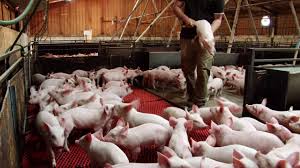
Lobsters carry their young for nine months, and can live 100 years. Researcher Michael Kuba says that lobsters are “amazingly smart.” They establish social relationships, and take long-distance seasonal journeys of 100 miles or more each year. When kept in tanks, they suffer from the stress of confinement, low oxygen levels, and crowding. Neurobiologist Tom Abrams says that lobsters have “a full array of senses.” Lobsters may feel even more pain than we would in similar situations. According to invertebrate zoologist Jaren G. Horsley, “The lobster does not have an autonomic nervous system that puts it into a state of shock when it is harmed. It probably feels itself being cut…I think the lobster is in a great deal of pain from being cut open…and feels all the pain until its nervous system is destroyed during cooking”. Don’t eat lobster.
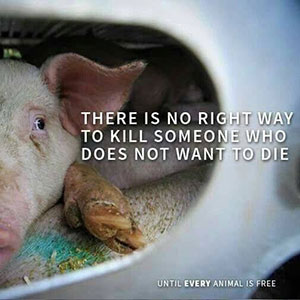
Crabs have well-developed senses of sight, smell, and taste. Research indicates that they have the ability to feel pain. Dr. Robert Elwood, from Queens University in Belfast, who has studied crustaceans for decades, says “Denying that crabs feel pain because they don’t have the same biology as mammals is like denying they can’t see because they don’t have a visual cortex.” Millions of crabs are caught, and killed yearly in the United States. With these doomed crabs, are birds, fish, and other marine animals, who are thrown back into the water dead or dying. Don’t eat crabs.
Shrimp is perhaps the most popular of all the shell fish. Each one is an individual who had a life and, suffered death. They did not volunteer to be someone’s dinner or appetizer. They preferred to live a long and happy life with their friends and family, just like everyone else. Have a heart.
Leather is a big business. It often involves completely conscious cows, and calves, being skinned alive, or thrown into scalding hot tanks. Dog and cat skins from Asia are used without being labeled as such. Much leather comes from India where the leather trade is perhaps the cruelest in the world. Most Indian animals used for leather are so sick and injured by the time they arrive at the slaughterhouse that they must be dragged. Many have hot chili peppers, and tobacco rubbed into their eyes. Their tail bones are painfully twisted, and broken. This is to force the weak animals into the slaughterhouse. Once inside, their throats are slit. Some have their legs hacked off, or are skinned while still alive.
Fur comes from animal such as foxes, minks, rabbits and others, who live their lives in cruel confinement. Then they are anally or vaginally electrocuted, or bludgeoned to death.
Wool. Sheep are docile, gentle animals who feel pain, fear, and loneliness. If not genetically manipulated, they would grow just enough wool to protect themselves from temperature extremes. Their fleece provides insulation from cold and heat.
Shearers are paid by volume, not by the hour, which encourages them to work quickly without any regard for the welfare of the sheep. Their carelessness leads to frequent injuries. Large wounds are sewn with needle and threat, and no pain relief. Strips of skin, teats, tail, and ears are often carelessly cut off during shearing. Sheep are punched, kicked, and stomped on, and hit in the face with electric clippers while being sheared. Workers stand on the sheep’s heads, necks, and hind legs. One shearer was seen hitting a lamb on the head with a hammer. Another used a sheep’s body to wipe her own urine off the floor. Another shearer repeatedly twisted, and bent a sheep’s neck, breaking it. In one case, a sheep died, was roasted, and eaten, by workers in full view of the other sheep, who knew what was going on.
A commonly used process called ‘mulesing” involves cutting huge chunks of skin from the sheep’s’ backside without painkillers. Within weeks of birth, lambs’ ears are hole punched, their tails chopped off, and males are castrated without painkillers. Male lambs are castrated between 2 and 8 weeks old, either by making an incision, and cutting their testicles off, or with a rubber ring used to cut off blood supply – one of the most painful methods of castration possible. If the lamb’s testicles do not fall off, they are cut off with clippers. Every year, hundreds of lambs die before the age of 8 weeks from exposure or starvation. Mature sheep die every year from disease, lack of shelter, and neglect.
Unwanted Australian sheep are shipped to the Middle East on crowded multilevel ships. These voyages can last for weeks. There is no food or water available for the sheep. When they arrive, they are dragged by their ears or legs, and slaughtered while still conscious.Standards and humane laws are non-existent there.
Down involves pulling the feathers out of ducks and geese, and leaving them bleeding and suffering. Many do not survive the ordeal.
Entertainment involves making compassionate choices. Animals used for entertainment in circuses, rodeos, zoos, aquariums, and seaquariums lead completely unnatural lives. There is nothing compassionate about being entertained by a captive orca. Tilikum, the orca, was featured in the documentary “Blackfish”. He was not alone. Lolita, another popular orca, has languished for nearly 50 years in Miami. She is in the smallest tank in North America. Orcas are social animals like elephants. Like many other orcas, Lolita has not had the companionship of family, friends, or any other orcas in nearly 50 years.
Zoos, pseudo-sanctuaries, traveling shows, and roadside displays use animals who are forced to spend their lives behind bars just to entertain the public. These animals live completely unnatural lives. Living conditions are often dismal, with animals confined to filthy, barren enclosures. Even the best environments can’t come close to matching the freedom that animals want and need. Animals are bored, lonely, and often abused by their caregivers. The symptoms of their suffering are rocking, swaying, pacing endlessly, and hurting themselves. Don’t go to zoos, aquariums, or sea shows.
Circuses are another cruel choice in entertainment. Animals in circuses are not volunteers. They are beaten, shocked with electric prods or small hand held easily concealed devices, chained, and whipped to make them perform unnatural and often dangerous tricks. Bullhooks, long sticks with sharp metal hooks, are used to discipline elephants. Elephants, big cats, bears, horses, and primates are beaten with sticks, axe handles, baseball bats, and metal pipes in order to break their spirits, and show them “who’s boss”.
Whips are used violently in training and cause lingering, intense pain. They are used again in performances as a reminder of what is waiting if the animal is unwilling or physically unable to perform correctly. In 2000 in White Plains, New York, an elephant named Petunia was beaten to death by ten trainers, for failing to perform her trick correctly due to advanced, untreated arthritis.
Most circus elephants were captured in the wild. Baby elephants born to these traumatized mothers are removed at birth, tied with ropes, and kept in isolation until they learn to fear their trainers. Then they are brutally “trained” which often leads to death. The mothers grieve inconsolably.
Tigers are naturally afraid of fire. ‘Training’ tigers so severely traumatizes them that they are willing to jump through hoops of fire. Tigers can become caught in these hoops, and suffer severe burns, if they survive. Big cats, bears, primates and other animals are forced to eat, drink, sleep, defecate, and urinate in the same cramped cages. They are often transported around the country in the worst conditions. A young tiger named Clyde died from heat while being transported though the Mohave dessert. His train car was not checked by circus personnel for days.There are many animal free circuses in the United States. Children can have fun without causing animals to suffer. Patronize cruelty free circuses, not animal circuses.
Rodeos are not compassionate. Animals used in rodeos are not aggressive by nature. Without the use of spurs, tail twisting, and bucking straps cinched tightly around their abdomen and groin, these frightened, and often docile animals wouldn’t even buck. Bulls and horses are tormented in the chutes prior to being released into the ring. The animals are terrorized into action when these ‘brave’ cowboys and cowgirls shove electric prods into them, twist their necks, yank them by their tails or legs, slam them to the ground, and otherwise batter them.
Injuries to these animals include deep internal organ bruising, hemorrhaging, bone fractures, ripped tendons, torn ligaments and muscles. The animals are used repeatedly before finally being sent to slaughter. They arrive at slaughterhouses so extensively bruised that often the only areas in which the skin is attached to the body is the head, neck, legs and belly. Rodeo animals can have as many as six or eight broken ribs protruding from the spine, often puncturing their lungs. It is not uncommon for there to be two or three gallons of free blood accumulated under the detached skin. Inspectors in slaughterhouses say the rodeo animals are in the worst condition they have ever seen.
Animal racing is not like athletic racing. Horses and dogs do not decide to race the way human athletes do. Instead, first they are breed through horrific methods. Mares (female horses) are immobilized using painful devices. Then a group of ten men forces the stallion (male horse) on the mare. No matter how much the stallion refuses, he cannot escape from the ten men. Stallions are used like this hundreds of times during a breeding season for steep stud fees. The female is impregnated repeatedly in search of the perfect offspring who can win races, and enrich their owners. The colts who show promise are subjected to many brutal, often life threatening techniques, to enhance performance. The many, many horses who do not make the grade are eliminated in the most horrific ways. Do not patronize horse races. Horses don’t bet on humans; humans shouldn’t bet on horses.

Dogs, specifically greyhounds, used in racing are killed when they don’t show promise for a racing career. Those who do race are killed when they no longer produce a profit. They are shot, bludgeoned, or euthanized. One track in Florida kills approximately 600 to 800 dogs yearly. Greyhounds are characteristically gentle and undemanding. They seldom bite no matter what pain or indignities are inflicted on them.
Horse-drawn carriages are often struck by vehicles resulting in severe injuries or death to horses, drivers, passengers, and passer-bys. Horses can become frightened, and race into traffic or onto sidewalks. Often veterinary care is refused by carriage owners for horses’ injuries. Horses are subjected to blistering heat and humidity, hot and hard pavement, traffic congestion, exhaust fumes, constant exposure to sun, long hours, inadequate rest, and are given little or no water. Their lives are jeopardized when they cannot cool themselves. Pavement temperature is often 50 degrees hotter than air. Horses enslaved by the carriage industry usually return from a treacherous day’s work to a filthy hard floor without clean bedding, no access to pasture, and inadequate food and water. They are often malnourished. They are prevented from socializing with each other, and often tied to poles.
Animal experimental is outdated, cruel and obsolete. There are computer simulated models available which more closely, and accurately, represent the human body. These give much more accurate results without the often scandalous and barbaric treatment of innocent animals. These do not cause unnecessary and cruel suffering to animals in labs. In addition, because of physiological variations between species, human reactions to drugs differ from those of animals.
Millions of rabbits, guinea pigs, rats and other mammals are force-fed cosmetics and household products. This results in convulsions, vomiting, and bleeding from the eyes, nose, mouth, and even death. Animals cower in fear in barren cages, often causing them to self-mutilate. Cages have been put through automatic washing machines while the animals are still in them. This carelessness scalds them to death. Dogs and cats who were formerly household pets are procured from Class B Dealers. These former pets often still have their collars on during painful, often deadly experiments. The only interaction lab animals have with humans is when they are restrained so that painful procedures can be performed, or when they are euthanized.
Baby chimps are taken at birth from their mothers. These mothers have been constrained at the neck, wrists, waist, and ankles, immobilizing them with their legs spread apart, on the so called ‘rape rack’. The female chimps are repeatedly artificially inseminated by male lab workers to cause conception. The baby chimps, and their mothers, never experience a single act of kindness during their sometimes 30 years of life. The baby chimps’ grow up constantly having blood drawn, being infected with various deadly diseases, and then are categorized as DNR – do not resuscitate.
Many companies manufacturing personal and household products have chosen to forego animal testing with no adverse results. Some companies test their products on people, not animals.
Drugs can represent cruelty. For example, Premarin is the ultimate in cruelty, and can often cause severe side effects in the women who use it. Premarin stands for PREgnant MARes urINe, or pregnant mare’s urine. Mares (female horses) are artificially inseminated, and forced to stand in stalls so small that they cannot lie down, or turn around. Cups are attached to their bodies to catch their urine. Water is restricted, causing the pregnant mares to be dehydrated when their body most needs water. This unhealthy, cruel treatment produces urine which is highly concentrated with hormones. When the baby colt is born, he or she is removed, and killed as an unwanted by-product of the drug industry. The poor mare who just lost her baby is impregnated again – if she is still standing. If not, she is also killed after a life of unbearable physical and emotional misery.
The purpose of this drug is to relieve symptoms of menopause in women. It has caused physical problems in women who are taking it. Vegan women do not use premarin or hormone replacement therapy (HRT) because they do not need it. Soy mimics estrogen in women’s bodies. Menopausal symptoms can be relieved by eating tofu. There are no adverse effects to men or boys from eating soy.
In addition, for relief of menopausal symptoms, there are cruelty free products such as Estriol-Care, and Natural Progesterone Cream. There are also bio-identical hormones synthetically produced in Labs from plant sources. These possess the same molecular structure as natural hormones. Dietary phytoestrogens are naturally occurring substances found in fruits, vegetables, and whole grains such as soy beans and alfalfa sprouts, and oil seeds such as flax seeds, which also reduce the intensity and frequency of hot flashes.
Working animals, sustainable energy and poverty reduction are related. The plight of working animals in the world today is abysmal. They are often undernourished, dehydrated, over worked, exhausted, victims of beatings, sodomy, torture devices, and more, all so that people can make a meager existence from their labor.
The plight of working animals is a sustainable energy / poverty reduction issue. People in energy poverty rely on working animals, but this does not reduce their poverty. These problems could be solved by using renewable energy replacements for work animals.
For example, if an Engineer from Tessla, the 100% solar powered electric car company, invented a solar powered vehicle to replace the load bearing animals, more agricultural products could be transported easier. This would not only eliminate the need to use overworked animals, but increase people’s incomes, reducing their poverty.
Money to pay for manufacture of these vehicles would come from investments, not donations. Investors would receive an acceptable return on investment. This is a win – win situation for all.
A solar vehicle is not impossible. There are currently hundreds of thousands of clean cook stoves being distributed worldwide as a UN initiative. These are a new invention. A wonderful, new “Solar Suitcase” was invented by the Husband of a Doctor who had spent time in Africa. She asked her Husband to create a device which could power an entire Hospital, or clinic, and fit in a suitcase. He did. The Solar Suitcases are being distributed all over Africa.
There are many solar manufacturers. First Solar in Arizona is one of many who can produce innovative inventions.
Distribution is not an issue. The famous Rock Star, Akon, born in Africa, has done an outstanding job of supplying and distributing solar devices in most of energy poor Africa. This could be done in Asia as well. Individual people would purchase the devices on a payment plan. The modest payments would be possible as their incomes, and their poverty reduced.